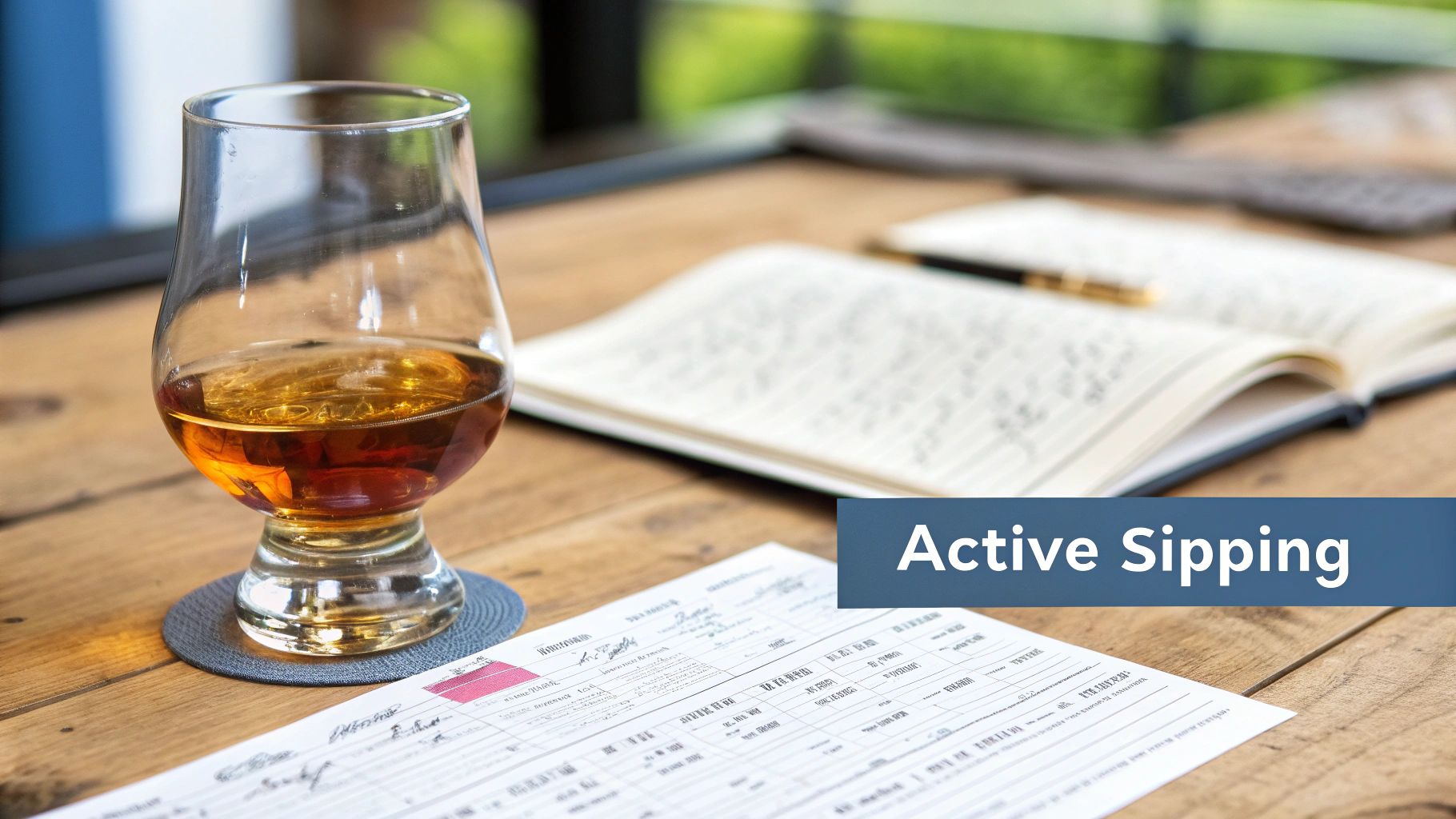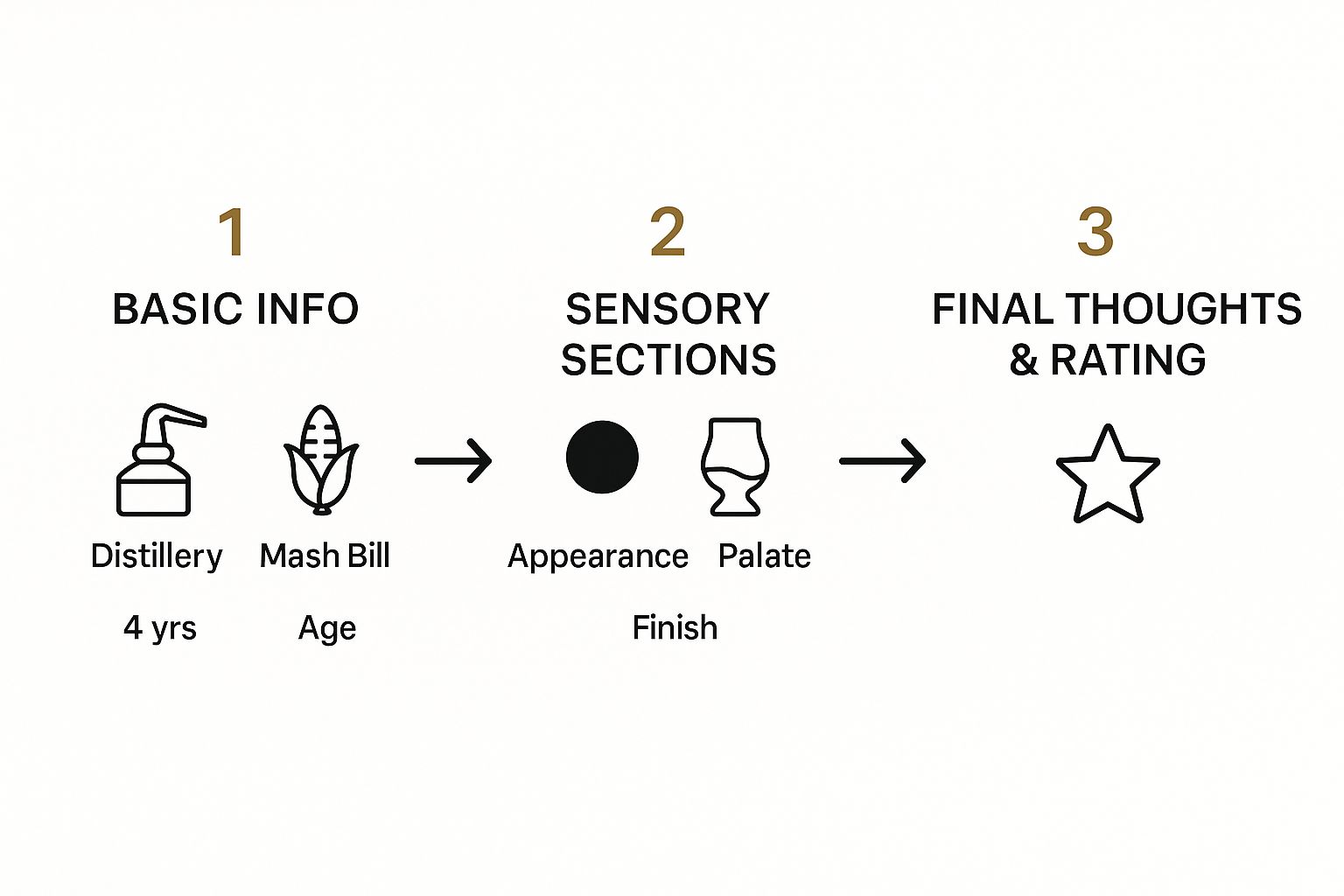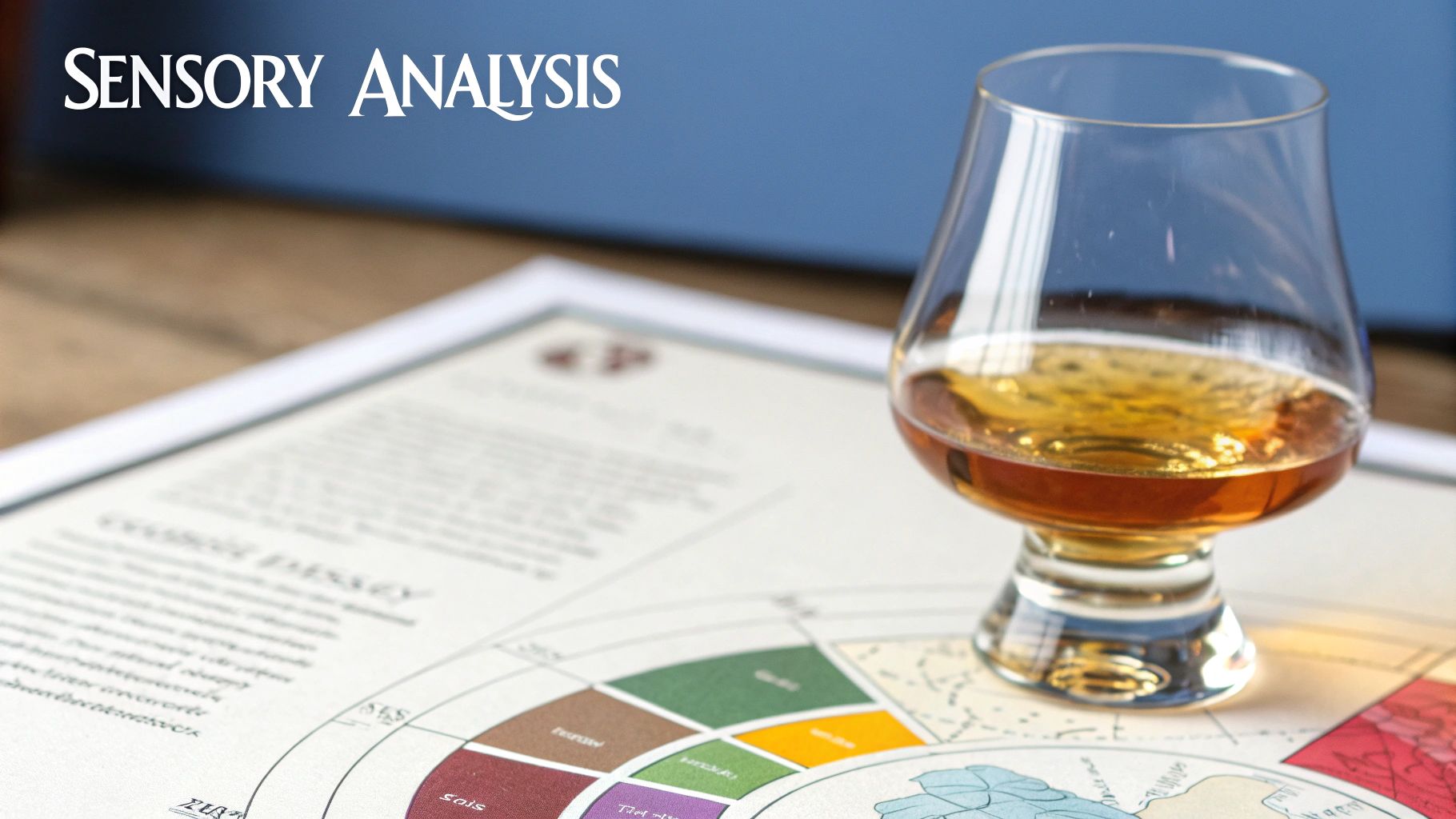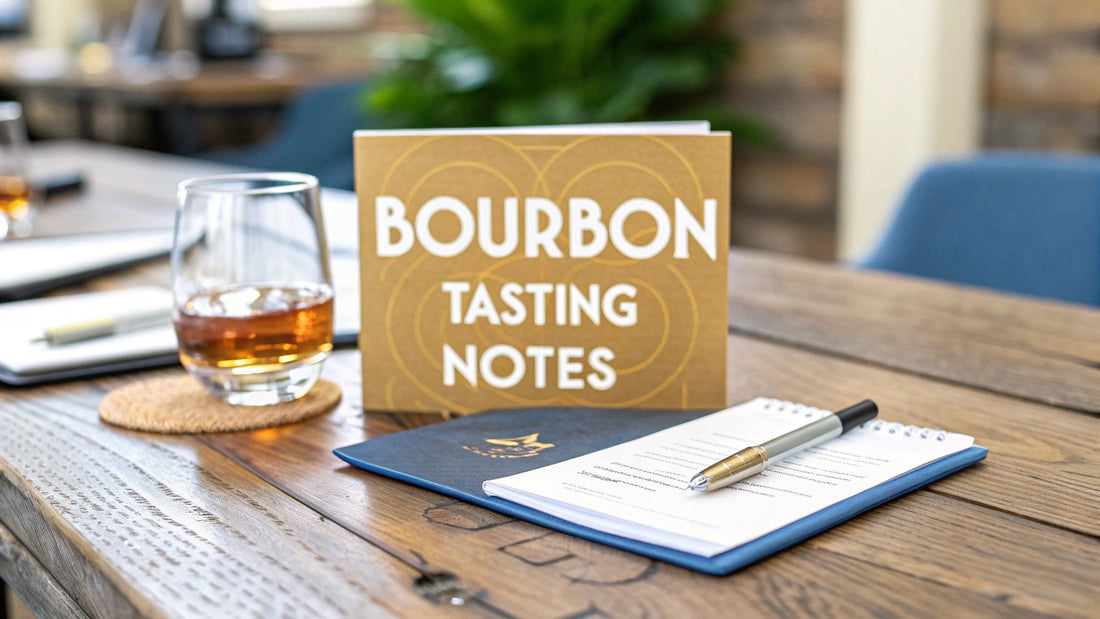If you want to translate what you're sipping into words you can actually remember and share, a structured bourbon tasting notes template is the single best tool you can have. It’s what helps you move from just liking a bourbon to understanding why you like it by guiding you through its appearance, aroma, taste, and finish. For anyone new to whiskey, this is your secret weapon.
Why a Tasting Template Unlocks Better Bourbon

Diving into bourbon for the first time can feel like learning a new language. You hear experts talking about "rye spice," "oaky tannins," and a "long, warming finish," and it can all be a little intimidating. Think of a tasting template as your personal translator, turning those abstract feelings into concrete observations.
This simple tool transforms passive sipping into an active, mindful experience. Instead of just landing on "good," a template prompts you to really consider each of a bourbon's characteristics. This structured approach helps you build a ‘palate memory,’ which makes it so much easier to recall and compare different whiskeys down the road.
From Sipping to Understanding
For anyone new to whiskey, a template provides a clear roadmap. It breaks down the whole process into four manageable pillars, making sure you don't miss any of the key details.
- Appearance: What does the color tell you? Could it hint at the bourbon's age or the type of barrel it was in?
- Nose (Aroma): Before you even take a sip, can you pick out scents like vanilla, caramel, fruit, or spice?
- Palate (Taste): What are the first flavors that hit your tongue? Is it sweet? Spicy? Maybe even a little earthy?
- Finish: After you swallow, how long do the flavors stick around? What notes are left behind?
This framework is essential because a massive part of a bourbon's character comes from its time spent in a charred oak barrel. When it's first distilled, bourbon is just a clear spirit called ‘white dog.’ It only gets its rich color and complex flavors from that interaction with the wood. This is where those classic notes of vanilla, caramel, and oak come from—the primary descriptors you’ll find on almost any bourbon tasting notes template. If you're curious, you can explore some more facts about bourbon's origins and characteristics.
New Drinker Tip: By consistently using a template, you start training your palate to pick up on the subtle differences between, say, a high-rye bourbon from New Riff and a wheated bourbon from a smaller craft distillery like Wyoming Whiskey. It’s honestly the fastest way to build confidence and start talking about what you're tasting like a seasoned pro.
Crafting Your Personalized Tasting Template
A generic, downloaded checklist is a fine place to start, but your palate is unique—so your template should be, too. Building your own bourbon tasting notes template from scratch, whether in a physical notebook or a simple notes app, ensures it captures what you care about most.
The foundation of any good template starts before you even pour the whiskey. Getting the basic, factual information down first provides the essential context for everything you're about to taste. Trust me, it’s crucial for comparing different bourbons down the road.
The Must-Have Data Points
Kick off your template with these core fields. Think of them as the bourbon's vital stats.
- Distillery: Who made it? This is key for tracking producers you enjoy, especially smaller craft operations. For example, is this from a distillery known for bold, grain-forward flavors, like Frey Ranch?
- Mash Bill: What grains are in the mix? Jotting down the percentages of corn, rye, wheat, and barley helps you connect specific flavor profiles directly to their source.
- Age Statement: How long did it sit in the barrel? An age statement can often hint at the depth of oak and complexity you’re about to experience.
- Proof (ABV): The alcohol content directly impacts the intensity of the flavor and the "heat" on your palate.
This infographic breaks down the essential flow for building your template, moving from basic info to your final rating.

As you can see, it’s a logical progression: start with the objective data, move into the subjective sensory stuff, and then wrap up with a personal conclusion.
To give you a clearer picture, here’s a simple table outlining the key sections you’ll want to build into your custom template.
Key Fields for Your Custom Bourbon Template
| Section | What to Record | Example Prompts |
|---|---|---|
| The Basics | Factual info about the whiskey. | Distillery, Mash Bill, Age, Proof (ABV), Price, Date Tasted |
| Appearance | Color and viscosity. | Color (honey, amber, mahogany), Legs (thick, thin, slow) |
| Nose (Aroma) | The scents you detect. | Fruits (cherry, citrus), Sweets (caramel, vanilla), Spices (cinnamon, rye), Oak |
| Palate (Taste) | The flavors on your tongue. | Flavor profile, Mouthfeel (oily, thin), Heat/Burn |
| Finish | The lingering taste after you swallow. | Length (short, medium, long), Lingering notes (oak, spice, sweetness) |
| Final Thoughts | Your overall impression and score. | Overall rating, "Would I buy again?", Pairings, General notes |
This structure gives you a solid framework to capture every important detail without feeling too rigid.
Your Sensory Sections and Final Rating
After logging the basics, create dedicated sections for your sensory experience: Appearance, Nose, Palate, and Finish. Don't just write "sweet." Prompt yourself to get more specific. Is it the rich sweetness of caramel, the lighter touch of honey, or the dark depth of brown sugar? These details are what make your notes genuinely useful later.
Finally, add a Final Thoughts & Rating section. This is where your template becomes truly yours.
New Drinker Tip: Don't feel tied to the standard 100-point scale if it doesn't work for you. Create your own system—maybe a simple 1-to-5 star rating or a "Would I Buy This Again?" checkbox. The whole point is to create a tool that reflects what you value in a whiskey, especially when you're just starting out.
This hands-on approach ensures your template becomes more than just a checklist; it evolves into a trusted companion on your bourbon journey, helping you discover exciting new pours from American craft distilleries and beyond.
Turning Sips into Stories

Alright, you’ve got your personalized bourbon tasting notes template ready to go. Now for the fun part: translating what you're sensing into actual words. This is where the magic happens, connecting your observations to the vocabulary on your sheet and turning a simple pour into a detailed story.
It really just boils down to a straightforward, four-part process that professionals use every single day.
We'll walk through how to approach each sensory stage—Appearance, Nose, Palate, and Finish—in a way that just makes sense. This structured method will give you the confidence to identify and record the unique character of any bourbon you pour, from a small-batch American craft whiskey like those from Garrison Brothers to a bottle you've seen a hundred times.
Start With Your Eyes
Before you even think about taking a sip, hold your glass up to the light. The color of a bourbon, which can range anywhere from pale gold to deep, rich mahogany, gives you the first clues about its journey.
A darker color often means it spent more time aging in a charred oak barrel. That simple observation can hint at deeper, more complex flavors like caramel, vanilla, and oak that you might find later. This whole practice of aging in charred oak, by the way, reportedly started around 1820 and fundamentally shaped bourbon's signature profile forever.
New Drinker Tip: Gently swirl the bourbon and watch the "legs" or "tears" run down the side of the glass. Thicker, slower-moving legs can be a sign of a higher proof or a richer, more viscous mouthfeel. It's not a perfect science, but it's another fun piece of the puzzle to jot down in your notes.
Master the Nose
Believe it or not, your sense of smell is responsible for a huge portion of what you taste. This makes "nosing" the whiskey an absolutely critical step, and one that new drinkers often rush through.
To do it right, bring the glass toward your nose slowly and keep your mouth slightly open. This simple trick prevents the alcohol vapor from overwhelming your senses and lets the more delicate aromas come through. Instead of one deep, aggressive inhale, take short, gentle sniffs. Think of it like you're hunting for familiar scents hiding in the glass.
- Sweet Notes: Can you pick out any vanilla, caramel, honey, or marshmallow?
- Fruity Notes: Look for dried fruit like cherry and raisin, or maybe something brighter like citrus peel.
- Spicy & Earthy Notes: Are there hints of baking spices like cinnamon and nutmeg? What about deeper notes of old oak and worn leather?
Decode the Palate and Finish
Finally, it's time for that first taste. Take a small sip and let the liquid coat your entire tongue. This isn't about just swallowing; it’s about paying close attention to the journey of flavors across your palate.
Notice the initial taste—is it sweet? Spicy? Fruity? Then, as it rests on your mid-palate, what other flavors start to emerge? Pay attention to the mouthfeel. Is it thin and light, or is it rich, oily, and creamy? For a deeper dive, you can check out our full guide on how to properly taste whiskey.
The Finish is all about what remains after you swallow. Does the flavor vanish almost immediately (a short finish), or does it linger with a pleasant warmth for a minute or more (a long finish)? Make a mental note of those final flavors you're left with—perhaps it’s a lingering oakiness, a sweet toffee note, or a gentle, fading spice.
A Real-World Guided Tasting Walkthrough
Theory is one thing, but the real confidence comes from practice. So, let’s put your new bourbon tasting notes template to the test with a real-world example. For this little exercise, we'll be using a bottle that’s widely respected in the American craft whiskey scene: High West Double Rye!.
Go ahead and pour about an ounce into your glass. We're going to walk through this together, translating what our senses tell us into simple, descriptive language.
Step-by-Step Tasting Notes
First things first, let's get the basic info down on the template. We're tasting High West Double Rye!, and it clocks in at 92 proof. Now, let's dive into the fun part.
- Appearance: Take a look at the color. It's a light, almost golden-hay color. Give the glass a quick swirl—see those thin, fast-moving legs? That's a little hint of its lively character before you even take a sip.
- Nose: Bring the glass up and take a few gentle sniffs. You don't need to stick your whole nose in there. Right off the bat, you'll probably get some crisp mint, cinnamon, and maybe a touch of clove. Underneath those spicier notes, you might find some sweet honey and even a little dill.
- Palate: Time for a small sip. Let it coat your tongue. That initial hit is a big rush of rye spice, just like the name promises. It’s quickly followed by honey, vanilla, and a botanical, almost gin-like quality that comes from the rye grain itself. The mouthfeel is smooth and what I'd call medium-bodied.
- Finish: After you swallow, what's left behind? For me, it’s a wave of warming cinnamon and mint that lingers nicely. The finish is clean, pleasantly spicy, and fades out at a medium length, leaving a final taste of sweet oak.
This process of tasting several whiskeys side-by-side is a fantastic way to sharpen your palate. If you want to dig deeper into that, check out our guide on how to set up a compelling whiskey tasting flight.
Remember, these are just my interpretations. Your palate might pick up on different notes, like baked apple instead of honey, and that’s perfectly fine. The goal isn’t to find the "right" answer but to accurately record your personal experience.
Now, it's your turn. Use this as a guide, but trust your own senses. Grab a bottle of your favorite bourbon—maybe something from a smaller American craft producer like Widow Jane—and see what story it tells you. This hands-on experience is what truly brings your bourbon tasting notes template to life, helping you build a sensory journal that's all your own.
Smarter Tasting and Craft Bourbons to Try
Now that you have a solid bourbon tasting notes template, let's talk about putting it to good use. A few simple tweaks to your process can completely change how you experience a whiskey, especially if you're just starting out.
One of the easiest upgrades is your glassware. Ditch the rocks glass and grab a Glencairn. That tulip shape isn't just for looks; it actively concentrates the aromas, funneling all those incredible scents right to your nose for a much more intense and detailed nosing experience. It's a total game-changer, especially for new drinkers trying to identify specific notes.
Another trick of the trade is adding a few drops of room-temperature water after your first neat sip. This works wonders on higher-proof bourbons, taming that initial alcohol heat and allowing more subtle, nuanced flavors to come forward. It can feel like you're unlocking a whole new layer of the spirit. Comparing a few different bourbons side-by-side in a flight is also a fantastic way to train your palate to pick out what makes each one unique.
Getting Started with American Craft Bourbons
The American craft whiskey scene is absolutely on fire right now, and it has been for a while. The demand for unique, premium spirits has exploded. Between 2009 and 2014 alone, supplier revenues for bourbon and Tennessee whiskey shot up by an incredible 46.7%. This boom was largely driven by people like us, drinkers looking for something more than the usual suspects on the shelf. You can read about the factors driving bourbon's popularity to get the full picture.
This incredible growth means there's a treasure trove of amazing craft bourbons out there just waiting to be discovered. Here are a few fantastic, accessible bottles that are perfect for breaking in your new tasting template:
- Frey Ranch Straight Bourbon Whiskey: This is a true "grain-to-glass" bourbon coming out of Nevada, and you can taste the dedication. Expect a beautiful profile of orange peel, honey, and clove with a rich, creamy finish. It’s a stellar introduction to what a four-grain mash bill can do.
- New Riff Kentucky Straight Bourbon (Bottled-in-Bond): If you like a little spice, this high-rye bourbon from Kentucky delivers in a big way. You'll likely pick up notes of cinnamon, vanilla, and dark cherry. Its bold, spicy character makes it a top contender for the best bourbon for drinking straight.
- Still Austin "The Musician" Straight Bourbon: Hailing from Texas, this one is known for being bright, fruity, and incredibly welcoming. Your tasting notes will probably fill up with caramel, apricot, and a touch of baked spice, making it an exceptionally smooth entry point for anyone new to bourbon.
These distilleries are at the forefront of the exciting innovation happening in American whiskey. Each one offers a truly distinct profile that will challenge your palate and help you fill out your tasting notes with confidence. This is how a simple drink transforms into a genuine discovery. Just pick one and see where the journey takes you.
Common Bourbon Tasting Questions Answered
As you start filling out your tasting notes, you'll find a few questions tend to pop up again and again. Getting a handle on these from the get-go makes the whole process more rewarding, especially if you're just starting to explore the world of bourbon.
Let’s dive into a few of the most common things new whiskey drinkers ask.
What Is the Best Glass for Tasting Bourbon?
The Glencairn glass is the gold standard for a reason. Its unique, tulip-like shape is engineered to funnel aromas directly to your nose, which makes a massive difference in how you experience the bourbon.
While a classic rocks glass is perfectly fine for enjoying a pour, it's not ideal for really digging in and analyzing what you're smelling. If you're serious about tasting, a Glencairn is the way to go. In a pinch? A standard white wine glass works surprisingly well, since the shape accomplishes a similar goal.
Should I Add Water or Ice When Tasting?
For the purest tasting experience, always start by sipping your bourbon neat. Get all your initial thoughts down first. Then, try adding just a few drops of room-temperature water. This can be a game-changer, especially with higher-proof American craft whiskeys.
That tiny bit of water "opens up" the bourbon, taming the alcohol's heat and letting more subtle flavors step forward. Avoid ice when you're doing a serious tasting, though. The cold will just numb your taste buds and dull the very notes you're trying to pick out.
New Drinker Tip: The real keys to developing your palate are practice and paying attention. Start noticing the smells and tastes in your everyday life—your morning coffee, fresh fruit from the market, the spices in your kitchen. You're building a sensory library in your mind.
When you bring a glass of bourbon to your nose, try to link what you're smelling to those memories. Is that a honey sweetness or more like caramel? Is that spice closer to cinnamon or clove? Another great way to train your palate is to taste different bourbons side-by-side in a flight. It's the quickest way to spot the nuances that make each one unique. Above all, remember it's a journey, so have fun with it!
Ready to take the guesswork out of discovering your next favorite craft bourbon? The Blind Barrels subscription sends you a curated blind tasting kit every quarter, allowing you to build your palate and find hidden gems without brand bias. Explore our tasting experiences at https://www.blindbarrels.com.
